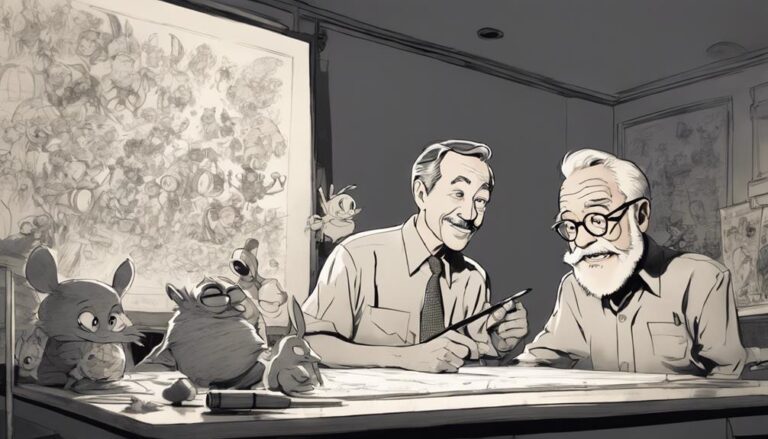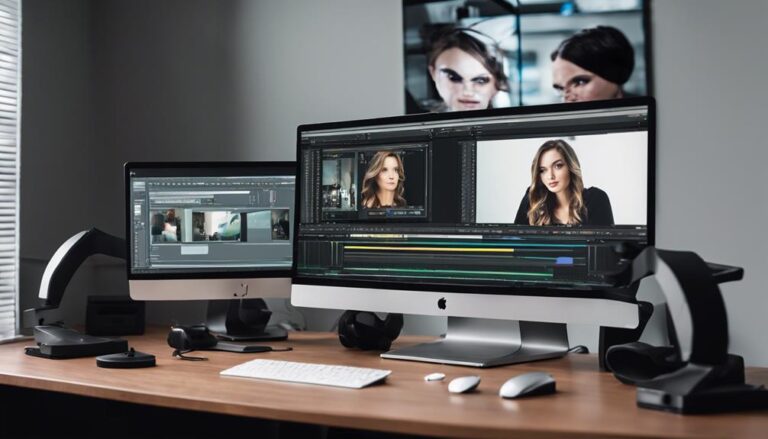Mastering 3D Animation for Game Development Essentials
As you step into the world of 3D animation for game development, you're likely to realize that it's a complex and multifaceted field. You'll need to grasp 3D math, animation terminology, and software tools to create high-quality animations that bring your game to life. But where do you start? With so many aspects to master, from keyframe animation to pipeline management, it's easy to feel overwhelmed. Yet, with a solid foundation in the essentials, you'll be well on your way to creating immersive gaming experiences that leave players in awe. But how do you get started?
Key Takeaways
- Mastering 3D math, including vectors, matrices, and quaternions, is crucial for creating realistic animations in game development.
- Understanding animation principles, such as keyframe animation and physics-based simulations, helps create engaging and responsive game environments.
- Selecting the right software and tools, such as Autodesk Maya, Blender, or 3ds Max, is essential for creating high-quality animations that meet project requirements.
- Optimizing animation performance by reducing complexity, compressing data, and leveraging level of detail (LOD) is vital for maintaining smooth gameplay.
Understanding 3D Animation Fundamentals
To effectively master 3D animation, you must first grasp the underlying principles that govern this complex and multifaceted field, starting with a thorough understanding of the fundamental elements that comprise 3D animation.
At its core, 3D animation relies heavily on 3D Math, which involves the manipulation of vectors, matrices, and quaternions to create complex movements and transformations.
You'll need to familiarize yourself with key concepts like Euler angles, axis-angle rotations, and spherical coordinates.
A solid foundation in Animation Terminology is also essential.
You should understand the difference between keyframe animation and physics-based simulations, as well as the role of kinematics and dynamics in creating realistic character movements.
Familiarity with concepts like interpolation, easing, and spline editing will also help you to craft smooth, nuanced animations.
By mastering these fundamental elements, you'll be well-equipped to tackle the challenges of 3D animation and bring your creative vision to life.
With a strong foundation in place, you'll be ready to explore the more advanced techniques and tools that will take your animations to the next level.
Choosing the Right 3D Software
With a solid grasp of the fundamental principles of 3D animation, you're now ready to select the 3D software that will help bring your creative vision to life.
This vital step requires a thorough software comparison to guarantee you choose the best fit for your project. Industry standards like Autodesk Maya, Blender, and 3ds Max are popular among game developers, but evaluating each option based on your specific needs is imperative.
Consider factors such as compatibility with your operating system, level of complexity, and the type of assets you need to create.
For example, if you're working on a character-driven game, you may prioritize software with advanced rigging and animation tools. On the other hand, if you're focused on environment design, you may opt for software with robust terrain and landscape generation features.
Building Efficient Animation Pipelines
How do you plan to streamline your animation workflow and maximize productivity, especially when working on complex, large-scale projects that require precise control over every stage of the animation process?
Building an efficient animation pipeline is vital to achieving this goal. You'll need to identify bottlenecks and areas for improvement in your current workflow, then develop a strategy to optimize each stage of the process.
This involves selecting the right animation tools for the job, such as 3D modeling software, rigging tools, and animation editors. By leveraging these tools effectively, you can automate repetitive tasks, reduce manual labor, and increase overall efficiency.
Pipeline optimization is key to achieving a seamless workflow. You'll need to establish clear communication channels between team members, define specific roles and responsibilities, and implement a version control system to track changes and revisions.
Creating Realistic Character Animations
When creating realistic character animations, you'll need to focus on capturing the subtleties of human movement patterns.
By studying how people move in the real world, you'll be able to identify the key elements that make an animation feel authentic.
Next, you'll apply these observations to your keyframe animation techniques, carefully crafting each pose and motion to bring your characters to life.
Human Movement Patterns
You need to understand the intricacies of human movement patterns to create realistic character animations that convincingly convey emotions, intentions, and personalities. This involves studying the way humans move, from the subtle tilts of the head to the fluid strides of the legs.
To achieve realistic movements, you'll need to grasp the fundamentals of body mechanics, including balance, weight distribution, and momentum.
Use motion capture technology to analyze and replicate real-life movements, verifying your characters' actions look authentic and natural.
Certify your characters' body proportions are accurate and consistent, taking into account factors like height, weight, and muscle mass.
Understand how joints move and rotate, and apply this knowledge to create realistic character movements.
Pay attention to your characters' center of gravity and balance, as this affects their overall movement and posture.
Don't forget to add subtle nuances to your characters' movements, such as slight hesitations or micro-expressions, to make them feel more human.
Keyframe Animation Techniques
By harnessing the power of keyframe animation, animators can craft realistic character movements that resonate with audiences, bringing their digital creations to life with precision and nuance.
As you explore into keyframe animation techniques, you'll learn to control the subtleties of character movement, from the way a character's joints rotate to the way their limbs sway.
Keyframe interpolation plays a crucial role in creating realistic motion, allowing you to define specific points in time and space, and then smoothly interpolating between them.
This technique enables you to achieve fluid, lifelike movements that would be difficult or impossible to achieve through traditional animation methods.
Through animation iteration, you'll refine your keyframe animation skills, experimenting with different techniques and fine-tuning your approach to achieve the desired level of realism.
Mastering 3D Camera and Lighting
In 3D animation, the camera and lighting systems work in tandem to create a visually stunning and immersive experience, allowing artists to craft a scene's mood, atmosphere, and narrative depth.
As you explore into mastering 3D camera and lighting, you'll discover the importance of precision and control.
To take your skills to the next level, focus on the following essential techniques:
- Camera Rigging: Learn to set up and animate cameras to capture the perfect shot, using techniques like orbiting, tracking, and crane movements.
Understand how to balance Light Intensity and Color Temperature to evoke the desired emotional response from your audience.
Master Depth of Field to draw attention to specific elements in your scene and create a sense of realism.
Experiment with Volumetric Lighting to add depth and atmosphere to your environments.
Animation Principles for Game Design
Game designers must incorporate fundamental animation principles to craft engaging, responsive, and immersive gaming experiences that meet players' expectations and elevate their overall interaction.
You'll need to ponder the game narrative and how animation can enhance the storytelling, creating a more cohesive and believable world. By understanding player psychology, you can design animations that elicit specific emotional responses, such as excitement, fear, or joy.
For instance, you can use animation to create a sense of weight and momentum, making the player feel more connected to their character. You can also employ animation to guide the player's attention, drawing them to important elements or objectives.
By mastering animation principles, you can create a more responsive and interactive environment, allowing players to feel more immersed in the game world. Remember, animation isn't just about aesthetics; it's a vital aspect of game design that can profoundly impact the player's experience.
Optimizing Animation for Performance
You've invested significant time and effort into crafting engaging animations, but now it's time to guarantee they don't compromise your game's performance. Optimizing animation for performance is vital to secure a seamless gaming experience.
To achieve this, you need to identify and address animation bottlenecks, which can substantially impact your game's performance metrics.
Limit animation complexity: Reduce the number of bones, vertices, and keyframes to minimize computational overhead.
Use animation compression: Leverage compression algorithms to reduce animation data size and improve loading times.
Optimize animation playback: Implement efficient playback techniques, such as using animation blueprints or state machines, to reduce CPU usage.
Leverage level of detail (LOD): Implement LOD techniques to reduce animation complexity and detail as the distance from the camera increases.
Profile and iterate: Regularly profile your game's performance and iterate on optimization techniques to achieve peak animation performance.
Frequently Asked Questions
Can I Use 3D Animation Software on a Low-End Computer?
You can try using 3D animation software on a low-end computer, but check the system requirements first; if needed, consider computer upgrades, like adding RAM or a graphics card, to guarantee smooth performance.
How Do I Protect My 3D Animation Work From Being Stolen?
You'll want to safeguard your 3D animation work by exploring legal protections like copyrights and trademarks, and incorporating digital watermarking techniques, such as steganography or fingerprinting, to deter theft and certify ownership verification.
Are Online Tutorials Enough to Learn 3D Animation?
You'll find that online tutorials can be a great starting point, but be prepared to face a steep learning curve if you rely solely on them, as tutorial quality varies and hands-on practice is essential.
Do I Need to Know How to Draw to Be a 3D Animator?
You don't necessarily need to know how to draw, but having an artistic foundation in traditional skills like perspective, proportion, and anatomy will substantially enhance your 3D animation workflow and attention to detail.
Can I Use 3D Animation Software for Non-Game Projects?
You can definitely use 3D animation software for non-game projects, such as architectural visualization to create stunning building designs or product advertising to showcase products in a realistic, attention-grabbing way.
Conclusion
You've now grasped the essentials of mastering 3D animation for game development.
By understanding 3D math, keyframe animation, and physics-based simulations, you're equipped to create realistic character animations and master 3D camera and lighting systems.
With an efficient pipeline and optimization techniques, you'll deliver high-quality animations while ensuring game performance.
Stay up-to-date with industry-standard software and animation principles to remain competitive in the game development industry.







